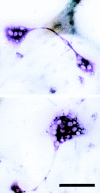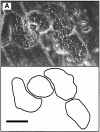The ligand for osteoprotegerin (OPGL) directly activates mature osteoclasts
- PMID: 10225954
- PMCID: PMC2185088
- DOI: 10.1083/jcb.145.3.527
The ligand for osteoprotegerin (OPGL) directly activates mature osteoclasts
Abstract
Osteoprotegerin (OPG) and OPG-ligand (OPGL) potently inhibit and stimulate, respectively, osteoclast differentiation (Simonet, W.S., D.L. Lacey, C.R. Dunstan, M. Kelley, M.-S. Chang, R. Luethy, H.Q. Nguyen, S. Wooden, L. Bennett, T. Boone, et al. 1997. Cell. 89:309-319; Lacey, D.L., E. Timms, H.-L. Tan, M.J. Kelley, C.R. Dunstan, T. Burgess, R. Elliott, A. Colombero, G. Elliott, S. Scully, et al. 1998. Cell. 93: 165-176), but their effects on mature osteoclasts are not well understood. Using primary cultures of rat osteoclasts on bone slices, we find that OPGL causes approximately sevenfold increase in total bone surface erosion. By scanning electron microscopy, OPGL-treated osteoclasts generate more clusters of lacunae on bone suggesting that multiple, spatially associated cycles of resorption have occurred. However, the size of individual resorption events are unchanged by OPGL treatment. Mechanistically, OPGL binds specifically to mature OCs and rapidly (within 30 min) induces actin ring formation; a marked cytoskeletal rearrangement that necessarily precedes bone resorption. Furthermore, we show that antibodies raised against the OPGL receptor, RANK, also induce actin ring formation. OPGL-treated mice exhibit increases in blood ionized Ca++ within 1 h after injections, consistent with immediate OC activation in vivo. Finally, we find that OPG blocks OPGL's effects on both actin ring formation and bone resorption. Together, these findings indicate that, in addition to their effects on OC precursors, OPGL and OPG have profound and direct effects on mature OCs and indicate that the OC receptor, RANK, mediates OPGL's effects.
Figures









References
-
- Anderson DM, Maraskovsky E, Billingsley WL, Dougall WC, Tometsko ME, Roux ER, Teepe MC, DuBose RF, Cosman D, Galibert L. A homologue of the TNF receptor and its ligand enhance T-cell growth and dendritic-cell function. Nature. 1997;390:175–179. - PubMed
-
- Arnett TR, Dempster DW. Effect of pH on bone resorption by rat osteoclasts in vitro. Endocrinology. 1986;119:119–124. - PubMed
-
- Brown MB, Forsythe AB. Robust tests for equality of variances. J Am Stat Assn. 1974;69:364–367.
MeSH terms
Substances
LinkOut - more resources
Full Text Sources
Other Literature Sources

